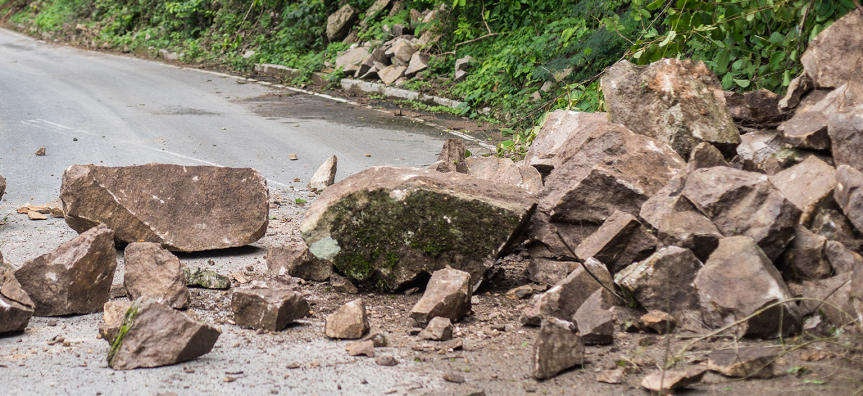
The lead agency for landslide emergencies is the NSW Police.
A landslide is the movement of a mass of rock, debris or earth down a slope.
Landslides have two things in common - they are the result of failure of the soil and rock materials that make up the hill slope and they are driven by gravity. They can vary in size from a single boulder in a rockfall or topple to tens of millions of cubic metres of material in a debris avalanche.
Landslides can be triggered by natural causes or by human activity. Natural causes include, saturation of slope material from rainfall or seepage, vibrations caused by earthquakes, volcanic eruptions; or undercutting of cliffs and banks by waves or rivers etc. Human activity may include the removal of vegetation; interference with or changes to natural drainage; leaking pipes (water, sewer); the modification of slopes by the construction of roads, railways or buildings; mining activities; vibrations from heavy traffic or blasting; or the displacement of rocks etc.
Landslide prone areas
Areas that are generally prone to landslide hazards include:
- Existing or old landslide areas.
- Areas at or on the top or base of slopes.
- Within or at the base of minor drainage hollows.
- Any sloping ground in an area known to have a landslide problem
Indicators of potential landslide activity
There are a number of signs to look out that may indicate potential landslide activity. However, it is important to note that a landslide may also occur in the absence of these:
- Saturated ground or seeps in areas that are not typically wet.
- New cracks and scarps or unusual bulges in the ground, roads or pavements.
- Movement of ancillary structures such as decks and patios in relation to a house.
- Sticking doors and windows, and visible open spaces indicating jambs and frames out of plumb.
- Tilting or cracking of concrete floors and foundations.
- Broken water lines and other underground utilities.
- Leaning telephone poles, trees, retaining walls or fences.
- Offset fence lines.
- Sunken or displaced road surfaces.
- Rapid increase in creek water levels, possibly accompanied by increased turbidity (soil content).
How you can prepare
There are a number of things that you can do to avoid or minimise the impact of landslides. These include:
- Request information and assistance from Council prior to land purchase or construction. This information could include, amongst other things, past landslide activity and any known landslide risk assessments.
- Consult a geotechnical engineer or engineering geologist for advice
- Do not undercut steep banks, develop near the top or base of steep slopes, or place fill on steep slopes
- Do not stand or seek cover below or near coastal cliffs or overhangs and be aware of potential dangers they represent. Take notice of signs giving warning of loose rocks and debris.
- Ensure your roof and stormwater is connected to an appropriate stormwater system.
- Learn more about the geological hazards in your area and become familiar with tell-tale signs of ground movement.
What to do if you suspect imminent landslide danger
- Contact NSW Police immediately on Ph: 000
- Inform affected neighbours
- Evacuate the area to a safe location.
